How Do You Make Keychains
It’s wild how something as tiny as Custom Keychains can spark big ideas. Aussies love their personal flair—footy teams, pets, cheeky quotes—and keychains have become more than just something to hold your keys. They're fast becoming little billboards of personality… and for some clever folks, a neat little side hustle.
A few years back, my mate Jen started whipping up resin keychains at her kitchen table. Next thing, she’s filling orders on Etsy faster than she can make 'em. All she did was mix a bit of creativity with the right materials and tools—no fancy gear needed. If you want a primer on the basics and materials, you can skim AllGoodsHub’s quick guide on How to Make Custom Keychains before diving in.
“What we’re seeing is a shift in value—people want things that feel personal,” says Laura, a product designer at AllGoodsHub. “Custom Keychains hit that sweet spot of small, meaningful, and affordable.”
Not sure which materials to pick? Or don’t have hours to spare? We’ll keep it simple. This guide cuts through the fluff and shows you what works—faster, smarter, and without blowing your budget. For deeper dives (materials, costs, production options), the AllGoodsHub knowledge base links sprinkled throughout will point you straight to relevant blog and product pages.
So if you're keen to start small but think big, stick around. We’ve got just the thing to get your hands moving and your ideas ticking.
Can You Really Start a Business with Keychains?
Finding Your Niche in Personalized Keychains
Kicking off your keychain biz? Step one: know your people and give them something they actually want. That’s where finding your niche comes in.
Not every customer is your customer. Get clear about your target audience—do they love travel, pets, food, or edgy humor?
Market research helps you figure out what people are already buying and what they wish they could find. If you plan to sell on marketplaces, Etsy’s pricing and testing guidance is a solid place to sanity-check demand while you validate price points.
Offer a unique selling proposition—maybe your personalized keychains are all made from reclaimed wood, or maybe you offer 24-hour custom design delivery. If you like the reclaimed/eco angle, there’s growing appetite for sustainable accessories like wooden pieces.
Do some competitive analysis. What are others doing? More importantly, what are they not doing that you could?
💡 Example: You could carve out a niche market creating custom designs for couples or event-based gifting. A little charm, a little wit, and a lot of personal touch. If you’re outsourcing production for events or larger runs, AllGoodsHub’s Where to Get Custom Keychains Made article outlines vendor options, turnaround, and eco choices.
Profit Margins and Market Demand for Acrylic and Wooden Keychains
Time to talk numbers—but don’t worry, this part’s more “a-ha!” than algebra. Understanding profit margins and market demand can be your unfair advantage.
Acrylic keychains have low production costs, especially in bulk. That’s great for volume selling. You can speed up production using pre-cut acrylic blanks and simple finishing workflows.
Wooden keychains offer a premium, earthy vibe—perfect for eco-conscious customers, even if the material sourcing might cost more. The sustainability pitch is credible given the renewable, biodegradable nature of wood.
Your pricing strategy needs to reflect both what it costs you and what your audience is willing to pay. Handmakers often start with frameworks like Paper + Spark’s handmade pricing formula and refine with live market tests from Etsy’s pricing playbook.
Higher sales volume can offset thin margins, especially for acrylic. But wooden pieces? You can price higher thanks to that handcrafted feel.
Hot tip: Blend the two in your catalog. Offer affordable acrylic for mass sales, and higher-priced wood pieces for gifting. Win-win. For Australia-based buyers, you can also funnel interest to custom keychains Australia to capture bulk or B2B requests.
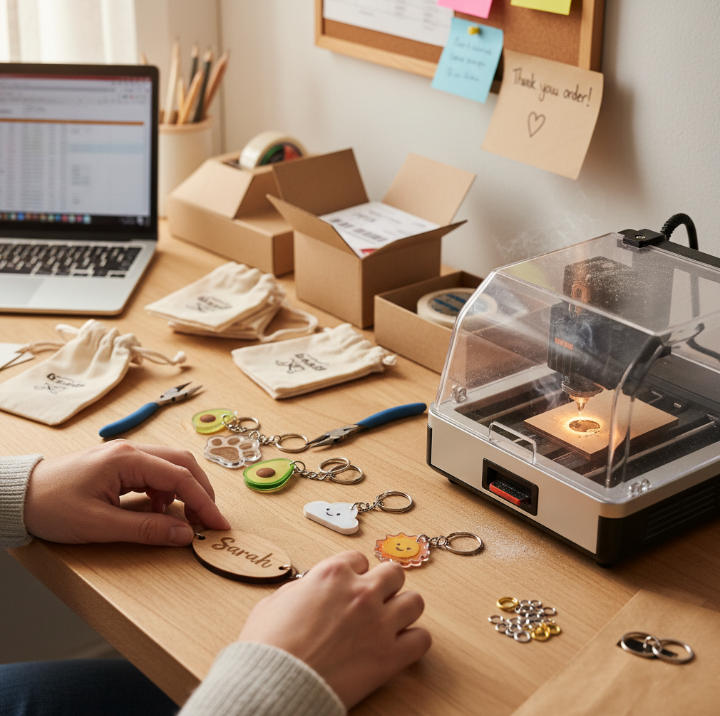
Scaling from Handmade Pieces to Custom Keychain Collections
You’ve sold a few handmade keychains, and orders are starting to pile up. Now what? Time to shift gears and think like a business.
Step 1: Streamline your manufacturing process
Ditch the one-by-one method. Pre-cut materials, standardized shapes, and reusable molds help move faster. Smart blanks with anti-scratch coatings and tight tolerances (common in modern acrylic blank manufacturing) can further reduce rework.
Step 2: Use basic inventory management tools
Even a simple spreadsheet can track what’s in stock and what’s flying off the shelves.
Step 3: Automate the boring stuff
Automate print templates, shipping label generation, or even customer emails.
Step 4: Start building custom keychain collections
Bundle items by theme—think “Beach Day,” “Pet Love,” or “Mini Tools”—so buyers have a reason to grab more than one. See ideas in Types of Custom Keychains.
Step 5: Optimize your supply chain
Work with suppliers who offer discounts at volume or handle part of your order fulfillment. That way, you focus on design while others help with delivery. For a local route, Where Can I Make Custom Keychains outlines options.
Scaling doesn’t mean losing your handmade charm—it just means more people get to enjoy it.
5 Materials You Must Try for Custom Keychains
From metal to fabric, your material choice can completely shape your keychain’s personality. Let’s walk through the five materials worth your attention.
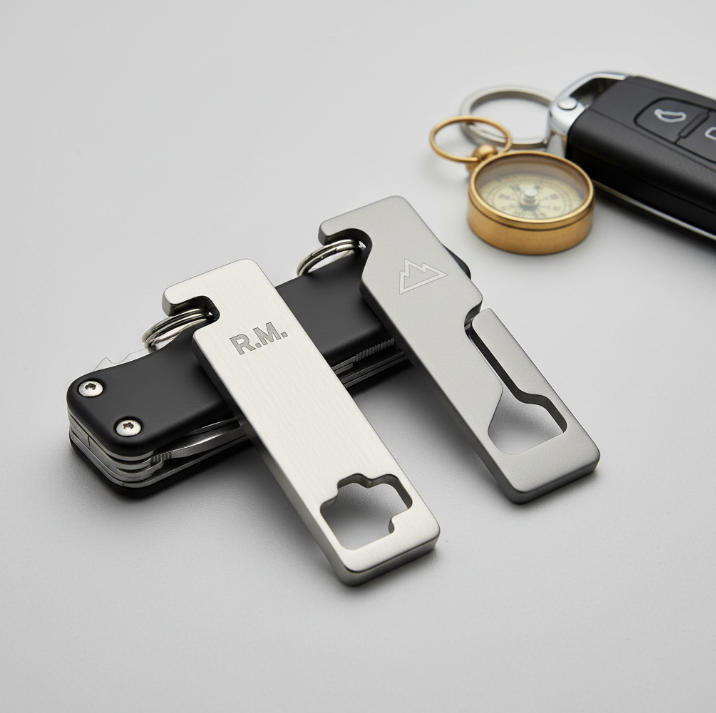
Stainless Steel and Aluminum — Durable Foundations for Metal Keychains
Strength That Sticks Around
Stainless steel is the king of toughness. It doesn't bend, dent, or corrode easily. That’s why it’s perfect for daily-carry metal keychains. For functional gear like openers, stainless generally outlasts aluminum over years of use.Aluminum: Strong But Feather-Light
Lighter than stainless steel but still pretty durable, aluminum's great for multi-tool designs without adding pocket bulk—though it’s typically softer than steel for heavy bottle-opening duty, which many users notice in practice (see EDC anecdotes).Aesthetic Edge
Metal finishes—matte or brushed—can give your keychains a premium look. You can laser-engrave initials or logos for that personal touch. If you want off-the-shelf ready options, check Custom Double-Sided Domed Keyring.Best Use Cases
These materials are ideal for keychain features like bottle openers, compasses, and other utility-driven add-ons. For quick ordering, AllGoodsHub’s Custom Printed Tin Bottle Opener Keychains or Zinc Alloy Bottle Opener Keychains are reliable starters.
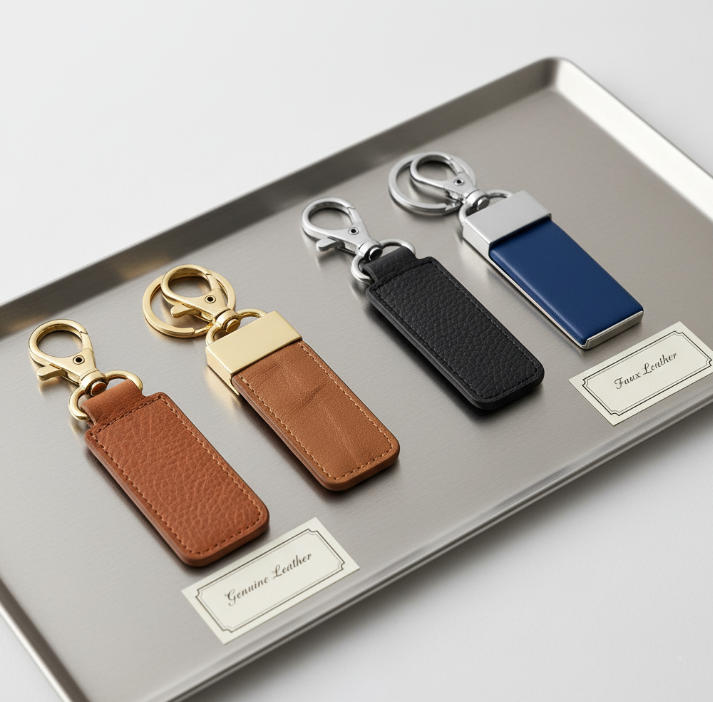
Genuine Leather and Faux Leather — Premium Appeal for Branded Designs
Genuine leather is all about class, while faux leather delivers style on a budget. Choosing between them depends on your target customer and purpose.
Genuine Leather gives off that luxury vibe—think premium corporate gifts. It's durable, develops a beautiful patina, and feels amazing.
Faux Leather, on the other hand, is animal-friendly and cost-effective. Great for larger batches of branded designs.
Both pair well with metal fittings like lobster clasps or key fobs for a refined finish.
Want texture? Go for pebbled. Want sleek? Smooth it is.
Ultimately, it’s about the feeling you want your customer to have when they grab that keychain: professional, stylish, or both. If you’re shopping rather than DIY’ing, browse Promotional Metal Gifts Australia for turnkey options.
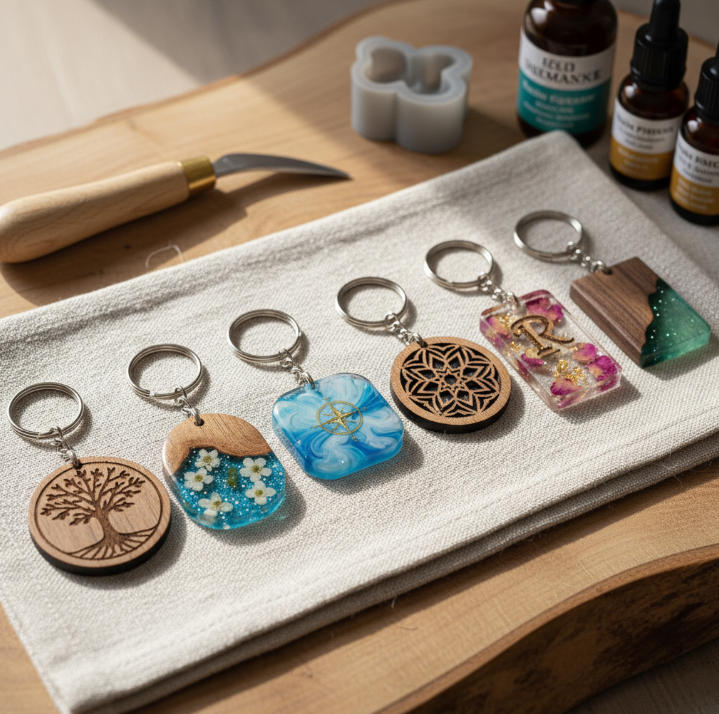
Wood and Resin — Eco-Friendly Options for Nature or Minimalist Themes
Wood and resin aren’t just about looking good—they make a statement. Here’s how they shine:
Wood brings soul. Each piece has a unique grain, so no two keychains are alike. Great for nature themes or rustic styles—and a strong sustainability message thanks to wood’s renewable, biodegradable profile.
Resin offers personality. You can embed glitter, flowers, or logos—whatever matches your vibe. Resin is colorful, glossy, and perfect for expressive creators. Makers weighing eco claims can contrast with broader sustainable product trends to position wooden SKUs.
If you're into eco-friendly selling points, wood is biodegradable and screams “sustainable.” Resin? Not so much eco-wise, but big on customization.
Mix them up—wood base with a resin overlay? Now that’s eye-catching. For manufacturing at scale, consider Custom 3D Rubber (PVC) Keychains as a durable alternative that still captures shaped detail.
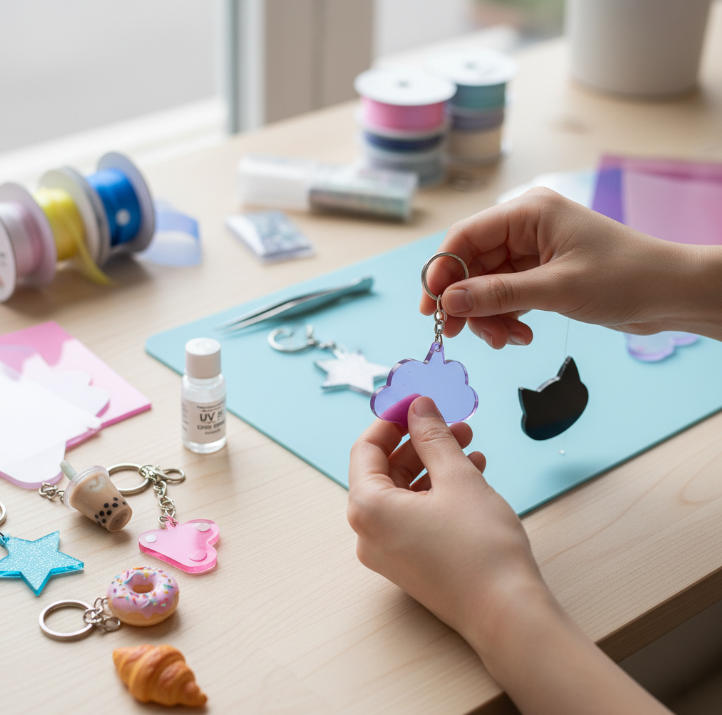
Acrylic — Lightweight and Perfect for Custom Shape Keychains
If you're into fun shapes and vibrant colors, acrylic is your best friend.
Why it rocks: It’s lightweight, easy to laser-cut, and available in nearly every color imaginable. Think stars, hearts, or your customer’s pet’s face. Production is faster when you start with pre-cut acrylic blanks or follow How to Make Custom Acrylic Keychains.
Popular Uses: Great for custom shape keychains or trendy food-themed designs (bubble tea, anyone?). See style ideas in Keychain Types Explained.
Tough Enough: While not metal-level strong, it’s still durable enough for everyday use; many makers add a thin resin “dome” for extra protection—note that resin coatings can yellow over time, so weigh clarity vs. longevity.
So if you want that “OMG, where’d you get that?” moment—acrylic’s the material to go with. If you’re still torn, compare Acrylic vs Resin Keychains for use-case fit.
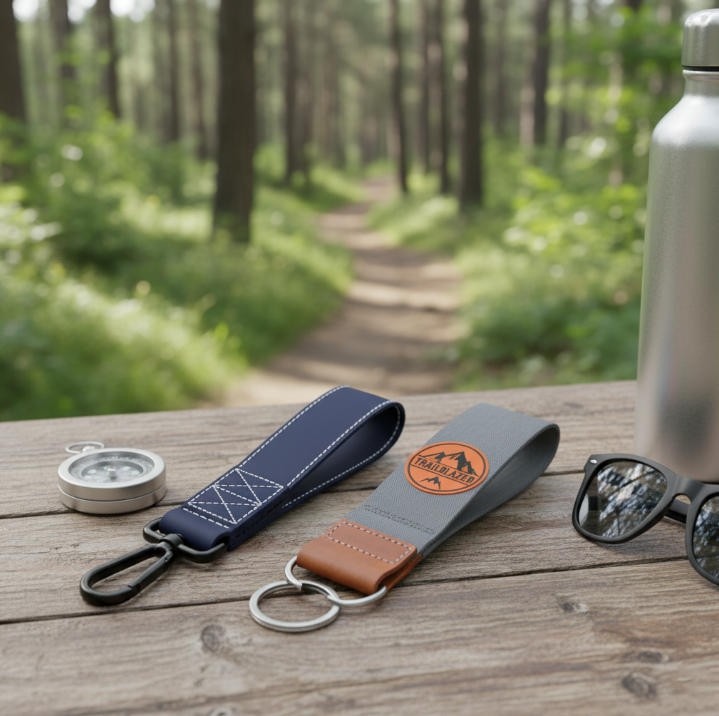
Nylon and Polyester — Fabric Keychains for Sporty or Outdoor Styles
These two are all about function and flair—perfect for active, on-the-go types.
Nylon: Smooth, flexible, and super durable. Handles rain and rough use like a champ. Ideal for sporty styles and outdoor promo gear—(nylon tends to have higher tensile strength/abrasion resistance).
Polyester: Budget-friendly and easy to customize. Excellent for printed designs and bold logos—great for everyday office or event use vs. nylon’s heavy-duty profile.
Pair them with carabiner clips or leather straps for a practical yet stylish combo.
Want to attract athletes, travelers, or campers? These fabric keychains are your go-to materials. If you want a ready-made base, try Double-Sided Embroidery Keychains or Woven Fabric Keyrings.
They’re rugged, customizable, and always up for adventure—just like your customers.
Resin vs. Acrylic: Which Makes Better Custom Keychains?
This cluster helps makers choose between resin and acrylic by comparing color, flexibility, and styling features that affect the final look and quality of custom keychains.
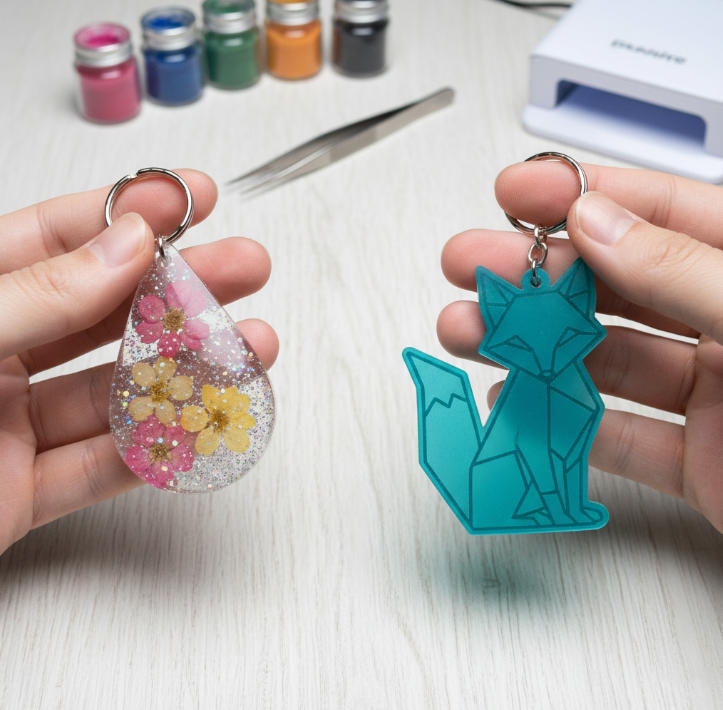
Clarity and Color Depth in Resin Keychains
Resin keychains are loved for their shine and depth—like looking into a polished gemstone.
Epoxy resin gives unmatched clarity, perfect for photo embeds or glitter swirls. Many makers highlight epoxy’s glass-like finish when comparing resin vs acrylic.
Pigment choices matter—a little mica powder can pop under the right lighting.
Transparent designs create a cool "floating" look, especially in heart or custom shapes.
Keep in mind: too much color can dull the clarity, while layering gives depth. Also remember that some coatings can yellow with UV exposure over time.
Use molds that enhance light refraction to make your resin keychains truly stand out.
Whether you're embedding flowers or tinting with translucent dyes, color depth isn't just a detail—it's the showstopper. For supplies and mold ideas, see Popular Keychain Mold Styles.
Weight, Flexibility, and Finish of Acrylic Keychains
Weight
Acrylic keychains are lightweight yet sturdy, making them perfect for everyday carry. Whether clipped to keys, bags, or zippers, they add flair without adding bulk.Flexibility
While it's rigid, laser-cut acrylic allows intricate custom shapes without breaking easily—great for logos or animals.Finish
Choose between matte, glossy, or frosted finishes to match your vibe. Glossy works great for music-themed designs, while matte fits minimalist aesthetics.Durability
It resists scratches better than you'd think and won't yellow over time like low-quality resins can. When in doubt, weigh pros/cons against resin using this head-to-head overview.Texture Options
Acrylic can be layered with vinyl, UV ink, or stickers for texture variation—and still remain lightweight.
From colorful cartoon charms to sleek brand tags, acrylic's balance of design freedom and toughness makes it a crowd-pleaser. To get started fast, AllGoodsHub’s How to Make Custom Acrylic Keychains covers design, sealing, and cost comparisons.
Choosing Shapes and Attachments for Design Consistency
Match Your Theme to Shape
Hearts: Great for personal or romantic gifts.
Stars & Animals: Perfect for kids’ themes or playful branding.
Custom shapes: Ideal for music or travel campaigns.
Pick the Right Attachment
Use lobster clasps for upscale leather or metal keychains.
Carabiner clips fit active lifestyles or sports-themed designs; they’re popular for quick, one-handed access (carabiners vs. rings and EDC notes).
Split rings offer standard, reliable utility for everyday styles—see this quick component primer on keychain parts.
Balance Aesthetics and Function
Consistency is key. A delicate resin heart deserves a minimal chain, not a chunky clasp. Similarly, a rugged multi-tool keychain calls for something sturdy like a key fob or thick leather strap.
In short: when your shapes, attachments, and features flow together, your whole keychain looks intentional—not like a mix-and-match mess. If you’re ordering hardware in bulk, AllGoodsHub’s Custom Carabiner Keychains in 13 Colours are a quick win.
Short on Time? Fast-Track Custom Keychains with This Method
Quick Assembly: Using Split Rings and Carabiner Clips
Getting your keychain assembly done in a flash? This trick’s for you.
Split rings are the go-to for that classic look and secure hold. Slide 'em on and you're done—see the component breakdown if you’re new to the parts.
Carabiner clips add outdoor or rugged vibes, especially for sporty or travel-themed designs. They also make attaching keys to bags or belts easier than traditional rings for quick one-handed use.
Combo hardware kits make life easier — get split rings, chains, and lobster clasps all in one.
Speed tip:
If you're handling a dozen pieces at once, use flat-nose pliers to speed up bulk assembly — no sore fingers, no wasted time.
Want flexibility? Use connectors that let you swap attachments without damage. That’s pro-level quick assembly. For pre-made hardware bases, see Custom Carabiner Keychains.
Pre-Cut Acrylic Blanks for Rapid Customization
Perfect for makers who want cool designs without spending hours cutting shapes.
Pre-cut acrylic blanks come in heart, star, and even animal shapes — all laser-cut and polished. Many vendors now ship tight-tolerance, anti-scratch blanks to cut rework and returns (manufacturing overview).
Just peel off the protective film, slap on your custom design, seal, and you’re golden.
These blanks are perfect for UV printing, vinyl stickers, or even a glossy resin topcoat.
"Rapid customization has transformed our production floor," says AllGoodsHub designer Marcie Lin, "Acrylic blanks cut time by 60% without compromising creativity."
Time-saving hack: Buy in bulk. You’ll thank yourself when orders stack up. For process walkthroughs, check How to Make Custom Acrylic Keychains and Resin Keychain Supplies List.
Adding Functional Features — Bottle Opener or LED Light Options
Bottle Opener Add-ons
Great for parties, camping, or giveaways
Pair well with metal keychains like aluminum or brass—though for longevity, stainless options generally hold up better under frequent use
Popular among food, drink, or bar-related promotions—ready-to-order picks include Custom Branded Zinc Alloy Bottle Opener Keychains
LED Light Modules
Add a glow to your custom keychain (bonus: it's useful!)—you’ll find lots of tiny, reliable keychain flashlights in the EDC world (tested picks).
Best suited for plastic or acrylic bodies
Works great with rectangular or oval shapes for clean fitting
Pro Combo Idea
LED + bottle opener on a multi-tool keychain? Now that's a conversation starter and a practical everyday carry item. For fast fulfillment, see Promotional Corporate Gifts Australia and Personalised Tin Bottle Opener Keychains.
Efficient Finishing and Packaging for Small Batches
Go for UV-protectant sprays or resin topcoats that dry in under 20 minutes; makers often weigh epoxy domes vs. bare acrylic depending on durability/yellowing trade-offs.
Pre-made kraft cards? Yes please. Slip your keychain in a plastic sleeve and boom — it's ready to gift or sell.
Want to stay organized? Batch your work: finish all sealing at once, then package in one go.
Don't skip quality checks. Even in small batches, clean edges, centered designs, and non-sticky finishes will set you apart. If you’d prefer manufactured consistency for corporate runs, consider Double-Sided Embroidery Keychains or Soft Flexible PVC Keychains.
Stay quick, but stay sharp — it’s all about balancing efficiency with presentation.
Conclusion
After getting your hands a bit dirty with resin, leather, or even stainless steel, you’ve probably realised that making keychains is more than a craft—it's a cracking little project with real potential. Whether you’re knocking them up for mates, markets, or maybe even turning it into a side hustle, you’ve now got the basics to get started. Custom Keychains can carry more than just keys—they tell stories, spark smiles, and open doors (sometimes literally if you add a bottle opener).
Start with acrylic or faux leather if you’re new—easy to cut, easy to win; if you’re deciding between them, skim Acrylic vs Resin Keychains and the Cost Comparison: DIY vs Manufacturer to choose your route
Grab a few split rings and carabiners to save time—(quick-release benefits); jump straight to Custom Carabiner Keychains if you want them pre-branded
Add a cheeky feature like a light or bottle opener for extra flair
Thinking business? Test your designs with small batches first using How to Make Custom Keychains and iterate with Etsy’s pricing guide
Don’t stress about having it all perfect. Aussie makers often say, “Start where you are, use what you’ve got.” Sometimes the best designs come from a happy accident or a late-night idea scratched out on a post-it.
Custom Keychain FAQ
What materials make the most reliable Custom Keychains?
Stainless steel and aluminum provide superior durability and longevity. Genuine leather develops a richer patina over time, while acrylic offers lightweight versatility. For creative, glossy finishes, resin remains a top choice.
How do people usually start selling keychains?
Most creators begin small—producing acrylic or wood keychains at home, then listing them on platforms like Etsy or selling at local markets. Defining a clear theme helps establish a consistent brand identity and attract loyal buyers.
What shapes are people drawn to for Custom Keychains?
Round and rectangular shapes offer a sleek and minimalist appeal. Hearts, stars, and animal silhouettes evoke personality and charm, while custom die-cut outlines add uniqueness and emotional resonance.
Is resin or acrylic better for clear designs?
Resin produces exceptional depth and glass-like shine, ideal for encapsulated or artistic designs. Acrylic is lighter, more affordable, and easier to process—making it optimal for bulk production.
What features do people enjoy in Custom Keychains?
Bottle openers and LED lights enhance practicality.
Whistles or compasses appeal to outdoor enthusiasts.
USB drives combine functionality with style.
How do you pick between real and faux leather?
Real leather exudes authenticity, aging beautifully with time. Faux leather offers affordability, consistency, and a cruelty-free option. Choose based on durability needs, aesthetic preferences, and brand values.
How do busy makers speed up Custom Keychain production?
Utilize pre-cut blanks and standardized hardware.
Adopt fast-drying sealants to shorten curing times.
Batch packaging and labeling to optimize fulfillment workflow.
Can keychains look good and stay eco-friendly?
Yes. Choose wood, bamboo, or plant-based resin materials for sustainability. Pair them with recycled metal rings or vegan leather straps for a polished, eco-conscious finish.
Which attachments work best for different keychains?
Split rings – ideal for daily use.
Lobster clasps – best for detachable or gift keychains.
Carabiners – perfect for outdoor or tactical designs.
Chains and straps – suited for fashion-oriented collections.
How do Custom Keychain collections attract more buyers?
Consistency drives collectibility. Build your collection around a shared theme (travel, music, food, etc.), maintain cohesive color palettes and design motifs, and consider limited editions to boost desirability.

Leave a comment